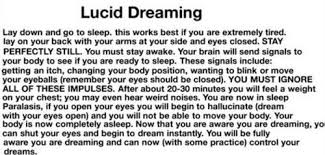Dream # 6 – the Prophetic Dream
Prophetic dreams are also known as precognitive dreams, and the people experiencing these dreams often report the ability to use them to foretell the future. Independent studies of these types of dreams are rare, and the jury remains out on whether this ability to see the future exists.
Dream # 2 – the Lucid Dream
Lucid dreaming takes place when the dreamer realizes that he or she is dreaming while still immersed in the dream. The occurrence of lucid dreams varies widely from person to person, with some people reporting never having lucid dreams and others reporting almost 100% lucid dreams.
Dream # 3 – the Nightmare
Many people are troubled by disturbing and frightening dreams, commonly known as nightmares. Young children in particular often suffer from nightmares brought on by fears of monsters in their closets and under the bed, as well as other types of fear.
It is estimated that most people spend between 70 and 120 minutes each day engaged in daydreaming. Daydreaming is thought to be a level of consciousness below that of a normal waking state but above that of sleep. Daydreaming falls about midway between these two extremes.
Dream # 7 – the Epic Dreams
The tiniest details of these dreams are often remembered for many years. These epic dreams may possess lots of symbols and meaning for the dreamer.
While most dreamers wake up when they realize that they are in a dream, other people are able to develop the ability to remain in the dream and take control of it. These people are able to become an active participant in their dreams, and to take the dream narrative where they want it to go. These people experience some of the most interesting and enjoyable dreams.
Some recurring dreams are uplifting and positive, but studies show the majority of recurring dreams to be negative in nature. Because the real life event that triggered it has remained unresolved, dreams can recur in this manner. Dealing with the real life trauma responsible for recurring nightmares is often the best way to banish the bad dream.
Some dreamers report experiencing narrative dreams, in which the dream picks up where it left off night after night. These dreams are somewhat rare, but the people who experience them report them to be memorable and very vivid. Keeping a dream journal can be a big help in both remembering and interpreting these kinds of dreams.
Dream researchers have discovered several distinct categories of dreams, and these dream categories can be very useful both to people attempting to interpret their own dreams and to professional psychologist and therapists striving to interpret the dreams of others. This article will discuss these categories of dreams.
Dream # 5 – the Healing Dream
Healing dreams are often seen as sending a message to the dreamer regarding his or her health. Healing dreams often spur the dreamer to take a long-delayed trip to the dentist or doctor.
Dream # 1 – the Daydream
While not technically a dream, since it takes place while we are awake, researchers are looking into just where the daydream fits on the spectrum of dreaming, and what it can teach us about more traditional dreams.
One non-supernatural explanation for the prophetic dream is that the subconscious mind pieces together bits of information encountered throughout the day, then puts them together in a form that makes sense to the dreamer.
These people are able to become an active participant in their dreams, and to take the dream narrative where they want it to go.
Lucid dreams are among the most fascinating subjects in all of dream research. Lucid dreaming takes place when the dreamer realizes that he or she is dreaming while still immersed in the dream. Lucid dreaming occurs in that moment when you tell yourself – “This is only a dream”. The occurrence of lucid dreams varies widely from person to person, with some people reporting never having lucid dreams and others reporting almost 100% lucid dreams.
During a daydream, we allow our imaginations to take us away from the mundane tasks of the day. As the mind is allowed to wander and conscious awareness is reduced, we can become lost in the fantasy or imaginary scenario.
Dream # 4 – the Recurring Dream
Most people have had a recurring dream at one point in their life, a dream that repeats itself, with minor variations or even none at all. Recurring dreams can be about any subject, and they focus on that subject night after night.
Many people who suffer from frequent nightmares report a history of real life problems, including psychiatric problems, problems with drugs or alcohol, or problems with family relationships. Treatment for frequent nightmares should therefore be aimed at dealing with the initial trauma or traumas that created the situation in the first place.
Of course nightmares are not confined to childhood, and many adults, particularly those who have suffered real life trauma, are particularly susceptible to nightmares. Those people suffering from post traumatic stress disorder (PTSD), such as soldiers returning from war, and rescue workers who have been through harrowing situations, report a higher incidence of nightmares than the public at large.







